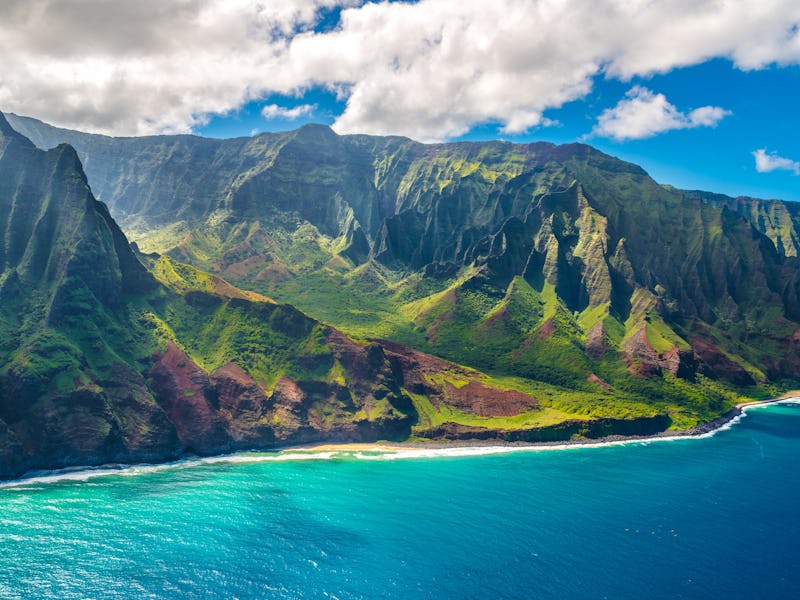Scientists want to transform mountains into gravity-based batteries
Rural areas can lack infrastructure, but some have mountains. Throw in some sand and there's a potential solution.

While renewable energy solutions are on the rise, they still face fundamental challenges when it comes to providing consistent power during times of less sun or wind. But new research may have found a solution that could help supplement these approaches, especially in more isolated island regions like Hawaii.
The paper, which was published this month in the journal Energy, describes a simplistic, yet effective, way to store energy that would make use of existing mountainous regions, canyons or disused mine shafts as the building site for what would be more or less a ski lift for sand. The approach is called Mountain Gravity Energy Storage (MEGS) and would use a crane to bring sand up from the bottom of the site, creating potential energy, and then return it again from the top to create electricity.
This is not the first energy approach to utilize mountains, “mountaintop removal mining” already does so by creating plateaus at the top of mountain sites by removing coal. But the MEGS approach would not only differ in being a much greener use of these mountains but by also creating a way to store energy as well.
Julian Hunt, coauthor of the study and IIASA researcher, also emphasized in a statement that this approach isn’t a replacement for other forms of energy creation but rather a way to supplement them.
“It is important to note that the MGES technology does not replace any current energy storage options but rather opens up new ways of storing energy and harnessing untapped hydropower potential in regions with high mountains,” said Hunt.
Not dissimilar to how a water turbine generates power, the study authors describe the energy of this system as being created by the multiplication of the sand’s mass, gravity, the height of the system as well as a small percentage of energy loss during loading and uploading of sand.
Hunt also notes in a statement that MEGS has the upper hand compared to hydro-power in a few crucial ways.
“One of the benefits of this system is that sand is cheap and, unlike water, it does not evaporate — so you never lose potential energy and it can be reused innumerable times. This makes it particularly interesting for dry regions,” said Hunt.
Energy is proportional to the mass of the sand, gravity and the height of the mountain (minus energy lost during the loading and unloading of sand).
But, while MEGS makes use of gravity, the authors warn that the descent of the sand still must be controlled in order to create maximum efficiency.
“The efficiency of the system would be close to zero if the sand or gravel moved close to free fall speed (around 33 m/s),” the authors write in the study. “Hence, the speed should be lower than 10 m/s in MGES to reach a relatively high efficiency.”
The bigger the height difference, the greater the power output, the authors write.
While its low tech approach is certainly appealing, the authors write that this approach is still far from being the most efficient way to generate power, but that it could fill an important gap between short-term energy storage and long-term energy storage. More isolated regions like Hawaii, Cape Verde, Madeira, and the Pacific Islands with steep mountainous terrain may particularly benefit from this kind of mid-level energy storage as those areas tend to have fewer large power reserves.
But before anyone goes running off to construct sand conveyors on mountainsides around the world, there are a couple drawbacks to keep in mind, note the researchers. Namely the impact and accessibility of these sites. For mountains in particular, the authors write that visual and social impact would need to be considered carefully before choosing a mountainside to build on. The accessibility of these remote mountaintops would also need to be solved before any construction could start. While other options, like disused mines, are also in consideration these would potentially face damage from water pooling at the lower sites.
The authors also write that solar power, a widespread intermittent power creator, might not benefit from this approach quite as much as wind, mostly due to sites primarily being built on mountains that may be in shaded areas.
That said, the authors write that this approach could still be useful for smaller energy grids, like those on isolated islands, that may be struggling to integrate any renewables into their system in the first place.
Read the abstract here:
The world is undergoing an energy transition with the inclusion of intermittent sources of energy in the grid. These variable renewable energy sources require energy storage solutions to be integrated smoothly over different time steps. In the near future, batteries can provide short-term storage solutions and pumped-hydro storage can provide long-term energy storage with large generation capacities. However, none of these technologies can provide long-term energy storage in grids with small demand. This paper proposes a new storage concept called Mountain Gravity Energy Storage (MGES) that could fill this gap in storage services. MGES systems move sand or gravel from a lower storage site to an upper elevation. The higher the height difference the greater the amount of stored energy in a given installed capacity, as this technology is constrained to the topography of the location. MGES cost varies from 50 to 100 $/MWh of stored energy and 1–2 M$/MW of installed capacity. MGES could be a feasible option for micro-grids, for example, small islands and isolated areas, and power systems where electricity costs are high, demand for energy storage is smaller than 20 MW with monthly or seasonal storage requirements.